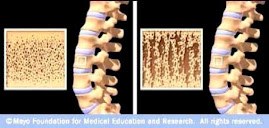"A recent study provides evidence that prior bisphosphonate
therapy results in blunting and delay of the BMD response to strontium
ranelate. In a prospective study in postmenopausal women with osteoporosis, 56
bisphosphonate-naïve women and 52 women treated with an oral bisphosphonate for
at least one year, who had stopped bisphosphonate therapy within the last
month, were given strontium ranelate 2 g daily, together with calcium and
vitamin D supplements. After 1 year of treatment, BMD in the lumbar spine
had increased 5.6% in bisphophonate-naïve women and by 2.1% in women previously
treated with bisphosphonates; at both 6 and 12 months the BMD increase in the
former group was significantly less than in the latter. At the total hip there
was no significant change in BMD at one year in the bisphophonate pretreated
women compared to an increase of 3.4% in the treatment naïve group. In an
extension of this study, it was shown that BMD in the spine in pretreated women
increased in parallel with treatment naïve women from 6 months onwards, whereas
some blunting of the BMD response at the hip was still observed after 2 years
of treatment. The most likely mechanism to explain these effects is that
bisphosphonates inhibit the uptake of strontium into bone because of
suppression of bone turnover and the consequent reduction in newly formed bone."
"Osteoporosis: Diagnosis and Management," Dale W. Stovall
(ed.), Wiley (Jul 15, 2013), 288 pages, Chapter 13, pages 202-203.



7 comments:
Hi Bone Lady
First, thanks so much for all this info.
I have been taking Prolia for 5 years and would like to stop. And as we now know, stopping is very dangerous. I was 3 months late with my last shot and had 2 fractures.
One suggestion is to get take Reclast after Prolia to limit the extreme rebound.
I would like to take Strontium but how do I get there. I'm so afraid of stopping the Prolia and suffering more fractures.
Can you point me towards any useful resources?
Thanks.
Hi Susan,
If you decide to take strontium citrate (SC), you can start anytime. There is no required waiting period after taking an osteoporosis drug. I waited a month after my last weekly Fosamax dose before starting SC because I did not know how long the adverse events I had been experiencing would linger.
Bisphosphonates (e.g., Fosamax, Reclast) and monoclonal antibodies (e.g., Prolia) are antiresorptives.
Parathyroid hormones (e.g., Forteo, TYMLOS) are anabolic agents, which help build new bone.
Strontium may have a dual action, i.e., both antiresorptive and anabolic.
You may want to consider a drug or supplement with a different mode of action than that of Prolia, but you should discuss your options with your bone specialist. I did not discuss switching to SC with my doctor, but I have not had any fractures.
One of my favorite resources is a case study on strontium citrate for osteoporosis with fragility fractures. The following link to my blog post includes a link to the original article. The post was written October 10, 2012, when Sara S. DeHart was 80 (nearly 81) years old. She died November 8, 2017, three weeks short of her 86th birthday.
http://strontiumforbones.blogspot.com/2012/10/case-study-on-strontium-citrate-for.html
Thank you so much. I will review this article. I have just spent several hours reviewing the details of all my bone density tests for the past ten years. Prolia has improved my T score but I don't think it improved bone quality. Even without the rebound effect I suspect the bone quality is worse.
My choices for another medication are limited. I would try Forteo but I have had radiation treatment for breast cancer. I am hoping Strontium will improve at least bone strength. Thank you again.
Susan,
Read my latest post, which includes links to the three posts I wrote about Sara DeHart, including the one I mentioned earlier, and the three strontium case studies she wrote. http://strontiumforbones.blogspot.com/2018/01/in-memory-of-sara-shackleford-dehart.html
There was also a clinical trial on strontium citrate called the COMB study, for short. It had good outcomes after one year.
https://www.hindawi.com/journals/jeph/2012/354151/
I hope strontium will improve your bone strength, and I believe it will.
I seem to remember that taking strontium can influence blood calcium levels. What is the protocol for having blood calcium done and stopping strontium for how long ahead of a blood draw?
happynana,
Strontium will not alter your actual blood calcium levels, but it will interact with laboratory tests using colorimetric methods and may give false results. Most automated chemistry analyzers use colorimetry to test for calcium.
I always stop taking strontium 12-14 days prior to my laboratory tests.
"Strontium interferes with colorimetric methods for the determination of blood and urinary calcium concentrations. Therefore, in medical practice, inductively coupled plasma atomic emission spectrometry or atomic absorption spectrometry methods should be used to ensure an accurate assessment of blood and urinary calcium concentrations."
https://ec.europa.eu/health/documents/community-register/2014/20140619128818/anx_128818_en.pdf
Thank you very much BoneLady, happynana
Post a Comment